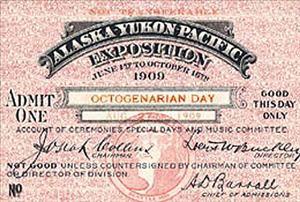On August 27, 1909, Octogenarian Day is celebrated at the Alaska-Yukon-Pacific Exposition on the grounds of the University of Washington in Seattle. The National Conservation Congress also has two well-attended meetings at the exposition that day, while the Welsh Eisteddfod sings its way through the afternoon and evening at the exposition. The exposition took place between June 1 and October 16, 1909, drawing more than three million people. Visitors came from around the state, the nation, and the world to view hundreds of educational exhibits, stroll the lushly manicured grounds, and be entertained on the Pay Streak midway, while Seattle promoted itself as a gateway to the rich resources of Alaska, the Yukon, and Asia. Each day (except Sunday) of the A-Y-P was designated as a Special Day for one or more groups. Special Days drew people involved in the featured organizations, and the resulting programs, lectures, ceremonies, parades, and athletic competitions gave local people a reason to visit again and again.
Octogenarian Day
“Giving the lie direct to Dr. Osler, who asserted that all men more than 60 years old are useless and ought to be painlessly killed, 200 or more octogenarians gathered today on the Alaska-Yukon-Pacific Exposition grounds to celebrate their day,” proclaimed the Seattle Daily Times on August 27, 1909. Octogenarian Day honored all of those over 80 years old (and a few over 90) attending the fair that day, and although some of the attendees had only recent or otherwise tenuous links to Washington’s early history, others had played a much bigger role.
Among these notable visitors were the three Boren siblings who were part of Seattle's founding Denny Party: Mary Anne Boren Denny (1822-1912), Carson Boren (1824-1912), and Louisa Boren Denny (1827-1916). Another octogenarian of long local tenure who was also present was Joseph Foster (b. 1828). Foster arrived in Seattle in April 1853 and later that year, along with his brother Stephen, staked a homestead claim in what is now Tukwila. The community bore their name for several of its early years.
Octogenarian Day ceremonies commenced at 11:30 a.m. in the Auditorium. Many of the octogenarians were accompanied by family members, which swelled attendance to several hundred. A-Y-P Director General Ira A. Nadeau greeted the crowd with a brief speech, and local historian and writer Thomas W. Prosch (1850-1915) answered on behalf of the crowd. Prosch's father, Charles Prosch, a pioneer newspaper publisher whose 1904 book, Reminiscences of Washington Territory, documented the settlement period in the Pacific Northwest, was also present. After a short program, prizes were awarded to the oldest woman (Mrs. C. G. Landis, age 94, won a silver tea set) and oldest man (John Cutler, 91, won a gold chain and charm). Mary Anne Boren Denny won a gold clock for being the oldest Washington resident with the longest local tenure, having arrived in 1851. There were some threats to have a short foot race to determine who would win the prize for liveliest octogenarian, but the decision was apparently made by more sedate means. George Ross, 83, won that prize: a silver loving cup.
After the ceremonies many visitors were content to just stick around for a couple of hours and tell their stories (some tales taller than others); many of the octogenarians had never met each other but were nonetheless delighted at the chance to meet their contemporaries, and together they roamed the fairgrounds well into the afternoon.
National Conservation Congress
There was no National Conservation Day at the exposition on August 27, 1909, but perhaps there should have been: The auditorium in the fine Arts Building was filled with at least 400 people for the 10 a.m. meeting of the National Conservation Congress, and was again filled to capacity with standing room only at the 2 p.m. session. It was the second day of the meeting, and the morning session kicked off with a reading of a telegram from President William Howard Taft (1857-1930), pledging his administration’s support to the conservation policies launched by his predecessor, Theodore Roosevelt (1858-1919).
Gifford Pinchot (1865-1946), the first chief of the U.S. Forest Service, spoke in the morning session. When rose to speak, the room erupted into applause which lasted for five minutes. In his speech, Pinchot spelled out the three primary objects of conservation: (1) to develop our natural resources; (2) to prevent needless waste and destruction of these resources; and (3) to see to it that the resources so developed and protected shall be used permanently for the welfare of the many instead of the profit of the few. Former California governor George Pardee (1857-1941) spoke at the afternoon session, and assailed the “rapacious private interests which are gobbling up our natural resources” (Seattle Post-Intelligencer, August 28, 1909, p. 13).
Welsh Eisteddfod
The Welsh Eisteddfod is a festival of music, literature, and performance, and at 2:30 the group held its first session of the day in the auditorium. The Auditorium was filled to capacity for both the 2:30 performance and a subsequent performance at 7:30. True to the Eisteddfod tradition, the Welsh held singing competitions in both sessions, but the evening session was the big one, with a competition for a $500 prize (nearly $10,000 in 2008 dollars).
The Ohio Male Chorus was declared the winner. The Ohio Male Chorus consisted of 50 singers, and had already won 100 prizes before winning another one at the A-Y-P Exposition. Various smaller prizes were also awarded to individual singers and performers. The Welsh Eisteddfod had its main event at the exposition the next day, when it held a mixed chorus competition involving several hundred singers competing for a grand prize of $1,000.

